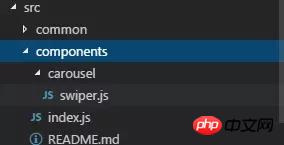react-native封裝插件swiper的使用方法
- 亚连原創
- 2018-05-25 16:43:352227瀏覽
這篇文章主要介紹了react-native封裝外掛swiper的使用方法,現在分享給大家,也給大家做個參考。
首先建立簡單的react-native專案,建立一個資料夾。然後用命令符輸入
react-native init swiper
創建完成之後開發項目,我用的vs

打開控制台,安裝swiper依賴。
安裝:npm i react-native-swiper --save
查看:npm view react-native-swiper
刪除:npm rm react-native-swiper --save
這裡還需要npm i 下更新下本地的依賴函式庫
啟動app專案
#ios: react-native run-ios
android: react-native run-android
開始上碼,在src裡面建立個components資料夾下邊建立個swiper.js文件,以及index.js,加上說明文檔

import PropTypes from 'prop-types';
import React, { Component } from 'react';
import { StyleSheet, TouchableWithoutFeedback, View } from 'react-native';
import RNSwiper from 'react-native-swiper';
const styles = StyleSheet.create({
activeDotWrapperStyle: {
//圆点样式
},
activeDotStyle: {
//圆点样式
},
dotStyle: {
//圆点样式
}
});
const activeDot = (
<View style={styles.activeDotWrapperStyle}>
<View style={styles.activeDotStyle} />
</View>
);
const dot = <View style={styles.dotStyle} />;
export class Carousel extends Component {
// Define component prop list
static propTypes = {
data: PropTypes.array,
height: PropTypes.number,
onPressItem: PropTypes.func,
renderItem: PropTypes.func.isRequired,
autoplay: PropTypes.bool,
autoplayTimeout: PropTypes.number
};
// Define props default value
static defaultProps = {
data: [],
height: 150,
autoplay: true,
autoplayTimeout: 2.5,
onPressItem: () => {},
renderItem: () => {}
};
// Define inner state
state = {
showSwiper: false
};
constructor(props) {
super(props);
this.handleItemPress = this.handleItemPress.bind(this);
}
componentDidMount() {
setTimeout(() => {
this.setState({ showSwiper: true });
});
}
handleItemPress(item) {
this.props.onPressItem(item);
}
_renderSwiperItem(item, index) {
return (
<TouchableWithoutFeedback key={index} onPress={() => this.handleItemPress(item)}>
<View style={[{ flex: 1 }]}>{this.props.renderItem(item)}</View>
</TouchableWithoutFeedback>
);
}
render() {
return this.props.data.length === 0 || !this.state.showSwiper ? null : (
<RNSwiper
height={this.props.height} //图片高度
activeDot={activeDot}
dot={dot}
style={{ backgroundColor: '#fff' }}
autoplay={this.props.autoplay} //是否自动轮播
autoplayTimeout={this.props.autoplayTimeout} //轮播秒数
>
{this.props.data.map((item, idx) => this._renderSwiperItem(item, idx))} //如果数据是个对象里面的数组加一个循环
</RNSwiper>
);
}
}
這是index.js檔案
import { Carousel } from './carousel/Carousel';
export { Carousel };
公共元件庫
這裡用來放置與業務無關的公共元件。元件實作必須考慮靈活性,擴展性,不能包含具體的業務邏輯。
元件必須以 你所做的業務命名 為前綴,如 TryCarousel.js 。每個元件必須單獨放在目錄中,目錄必須全小寫(中橫線分割),如 carousel/TryCarousel.js 。
一個基本的元件結構:
import PropTypes from 'prop-types';
import React, { Component } from 'react';
export class TryCarousel extends Component {
// Define component prop list
static propTypes = {};
// Define props default value
static defaultProps = {};
// Define inner state
state = {};
constructor(props) {
super(props);
}
// LifeCycle Hooks
// Prototype Functions
// Ensure the latest function is render
render() {}
}
#元件清單
##carousel(輪播元件)
主要用於通用的圖片輪播,能夠提供點擊事件回應。 Usage:Props:| #描述 | |||
|---|---|---|---|
| ##類型 | 預設值 | ||
| #data | Carousel資料來源 | #Array | |
| height | Carousel的高度 | number | |
| onPressItem | 點擊Carousel Item的時候觸發 | fn | |
| ##renderItem | 具體的渲染Item的方法,請參考FlatList | fn | - |
| #autoplay | ##是否自動切換 | bool | true |
import { HigoCarousel } from '../../components';
<Carousel
data={} //接受的数据
onPressItem={} //点击事件
height={} //图片高度
autoplay={} //是否自动播放
autoplayTimeout={} //过渡时间
renderItem={item => {
return <Image source={{ uri: item.imageSource }} style={{ flex: 1 }} />;
}} //图片
/>
上面是我整理給大家的,希望今後會對大家有幫助。
相關文章:
####關於Ajax技術中servlet末端的輸出流###########################
以上是react-native封裝插件swiper的使用方法的詳細內容。更多資訊請關注PHP中文網其他相關文章!
陳述:
本文內容由網友自願投稿,版權歸原作者所有。本站不承擔相應的法律責任。如發現涉嫌抄襲或侵權的內容,請聯絡admin@php.cn
上一篇:JS 實作快取演算法的範例下一篇:JS 實作快取演算法的範例

